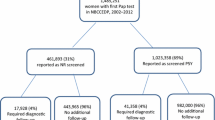Abstract
Objective: To describe differences in cervical screening and biopsy results by race or ethnicity from women in the National Breast and Cervical Cancer Early Detection Program (NBCCEDP).
Methods: We examined the percentage of abnormalities detected by Papanicolaou (Pap) tests and the rate of biopsy-diagnosed high-grade precancerous or cancerous lesions by racial or ethnic group.
Results: Almost half the 628,085 women screened were members of racial or ethnic minority groups. American Indian or Alaska Native women were more likely than others to report never having had a prior Pap test. American Indian or Alaska Native women had the highest proportion of abnormal Pap tests for first program screens (4.4%), followed by blacks (3.2%), whites (3.0%), Hispanics (2.7%), and Asians or Pacific Islanders (1.9%). Whites had the highest biopsy detection rate of high-grade lesions for first program screens (9.9 per 1000 Pap tests), followed by Hispanics (7.6), blacks (7.1), American Indians or Alaska Natives (6.7), and Asians or Pacific Islanders (5.4).
Conclusions: This program provides important data on the prevalence of cervical neoplasia among diverse populations. Our findings that black women with a high-grade Pap test were less likely to get a work-up are disconcerting and merit further study and ultimate correction.
Similar content being viewed by others
References
American Cancer Society (2000) Cancer Facts and Figures. Atlanta: American Cancer Society.
Kurman RJ, Henson DE, Herbst AL, Noller KL, Schiffman MH (1994) Interim guidelines for management of abnormal cervical cytology. JAMA 271: 1866-1869.
Beral V, Hermon C, Munoz N, Devesa SS (1994) Cervical cancer. Cancer Surv: Trends in Cancer Incidence and Mortality 19-20: 265-285.
Guidozzi F (1996) Screening for cervical cancer. Obstet Gynecol Surv 51: 247-252.
Hakama M, Miller AB, Day NE (1986) In: Screening for Cancer of the Uterine Cervix. Scientific Publications No. 76. Lyon: International Agency for Research on Cancer (IARC).
SEER Monograph. Racial/Ethnic Patterns of Cancer in the United States, 1988-1992. US Department of Health and Human Services. Bethesda: National Institutes of Health, pp. 36-37.
Yoder L, Rubin M (1992) The epidemiology of cervical cancer and its precursors. Oncol Nurs Forum 19: 485-493.
Skaer TL, Robison LM, Sclar DA, Harding GH (1996) Cancer-screening determinants among Hispanic women using migrant health clinics. J Health Care Poor Underserved 7: 338-354.
Funch D (1986) Socioeconomic status and survival for breast and cervical cancer. Women Health 11: 37-54.
Henson RM, Wyatt SW, Lee NC (1996) The National Breast and Cervical Cancer Early Detection Program: a comprehensive public health response to two major health issues for women. J Public Health Mgmt 2: 36-47.
May DS, Lee NC, Nadel MR, Henson RM, Miller DS (1998) The National Breast and Cervical Cancer Early Detection Program: report on the first four years of mammography provided to medically underserved women. Am J Roentgenol 170: 97-104.
Lawson H, Lee NC, Thames SF, Henson R, Miller DS (1998) Cervical cancer screening among low-income women: results from a national screening program, 1991-1995. Obstet Gynecol 92: 745-752.
Office of Management and Budget (1978) Directive No. 15: Race and ethnic standards for federal statistics and administrative reporting Statistical Policy Handbook. US Department of Commerce, Office of Federal Statistical Policy and Standards.
Kurman RJ, Solomon D (1993) The Bethesda System for Reporting Cervical/Vaginal Cytologic Diagnoses. New York: Springer-Verlag.
Breslow NE, Day NE (1987) The design and analysis of cohort studies. In: Statistical Methods in Cancer Research, Vol. II. Lyon: International Agency for Research on Cancer (IARC Scientific Publications no. 82), pp. 58-59.
American Association of Central Cancer Registries (1993). Working Group on Pre-Invasive Cervical Neoplasia and Population-Based Cancer Registries. Final Subcommittee Report. Conference held 5-6 April,1993, Rockville, Maryland.
Williams D (1998) The quality of racial data. Closing the Gap-Special Issue. A Newsletter of the Office of Minority Health, US Department of Health and Human Services. March1998.
Michielutte R, Dignan MB, Wells HB, et al. (1991) Errors in reporting cervical screening among public health clinic patients. J Clin Epidemiol 44: 403-408.
Author information
Authors and Affiliations
Rights and permissions
About this article
Cite this article
Benard, V.B., Lee, N.C., Piper, M. et al. Race-specific results of Papanicolaou testing and the rate of cervical neoplasia in the National Breast and Cervical Cancer Early Detection Program, 1991–1998 (United States). Cancer Causes Control 12, 61–68 (2001). https://doi.org/10.1023/A:1008959019019
Issue Date:
DOI: https://doi.org/10.1023/A:1008959019019



